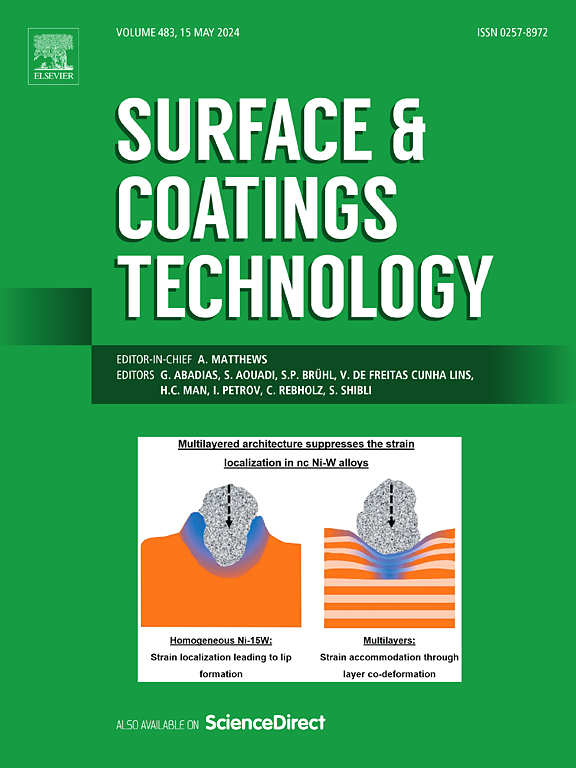Surface strengthening and wear resistance enhancement of electron beam powder bed fusion fabricated Ni-based superalloys via laser shock peening
IF 5.3
2区 材料科学
Q1 MATERIALS SCIENCE, COATINGS & FILMS
引用次数: 0
Abstract
Electron beam powder bed fusion (EBPBF) enables the direct fabrication of non-weldable superalloy components; however, surface strengthening remains essential to enhance wear performance. This study investigates the effect of laser shock peening (LSP) on the 600 °C dry sliding wear performance of EBPBF-fabricated IN738 superalloys. LSP introduces a millimeter-scale work-hardened layer through the formation of high-density dislocation structures, including dislocation pairs, stacking faults, and Lomer-Cottrell (L-C) locks, without causing grain refinement or texture changes. Notably, the LSP-treated sample using laser energy of 5 J showcases the most pronounced hardening effect and demonstrates the greatest improvements in wear resistance, with an average coefficient of friction (COF) and wear rate reduced by 23.6 % and 73.6 %, respectively, compared to the as-received sample. This improvement is primarily attributed to the synergistic effects of the work-hardened layer and compressive residual stress (CRS). Additionally, LSP-induced dislocation structures provide a fast pathway for inward oxygen diffusion, facilitating the formation of a uniform oxide layer that protects the surface from wear mass loss and lowers the COF through self-lubricating. As a consequence, LSP treatment shifts the wear mechanism from adhesive wear in the untreated samples to a combination of abrasive and oxidative wear in LSP-treated samples. This study provides valuable insights into the role of the LSP-induced surface-strengthening effect in enhancing wear resistance and highlights the potential of combining surface-strengthening technologies with additive manufacturing for the production of high-performance aerospace components.
激光冲击强化电子束粉末床熔合制备镍基高温合金的表面强化和耐磨性
电子束粉末床熔合(EBPBF)可以直接制造不可焊接的高温合金部件;然而,表面强化仍然是提高耐磨性能的必要条件。研究了激光冲击强化(LSP)对ebpbf制备的IN738高温合金600℃干滑动磨损性能的影响。LSP通过形成高密度的位错结构,包括位错对、层错、L-C锁等,在不引起晶粒细化和织构改变的情况下,引入了毫米级的加工硬化层。值得注意的是,使用5 J激光能量的lsp处理的样品显示出最明显的硬化效果,并显示出最大的耐磨性改善,与接收样品相比,平均摩擦系数(COF)和磨损率分别降低了23.6%和73.6%。这种改善主要归因于加工硬化层和压缩残余应力(CRS)的协同作用。此外,lsp诱导的位错结构为氧气向内扩散提供了快速途径,促进了均匀氧化层的形成,保护表面免受磨损质量损失,并通过自润滑降低了COF。因此,LSP处理将磨损机制从未处理样品的粘着磨损转变为LSP处理样品的磨粒和氧化磨损的组合。这项研究为lsp诱导的表面强化效应在提高耐磨性方面的作用提供了有价值的见解,并强调了将表面强化技术与增材制造相结合以生产高性能航空航天部件的潜力。
本文章由计算机程序翻译,如有差异,请以英文原文为准。
求助全文
约1分钟内获得全文
求助全文
来源期刊

Surface & Coatings Technology
工程技术-材料科学:膜
CiteScore
10.00
自引率
11.10%
发文量
921
审稿时长
19 days
期刊介绍:
Surface and Coatings Technology is an international archival journal publishing scientific papers on significant developments in surface and interface engineering to modify and improve the surface properties of materials for protection in demanding contact conditions or aggressive environments, or for enhanced functional performance. Contributions range from original scientific articles concerned with fundamental and applied aspects of research or direct applications of metallic, inorganic, organic and composite coatings, to invited reviews of current technology in specific areas. Papers submitted to this journal are expected to be in line with the following aspects in processes, and properties/performance:
A. Processes: Physical and chemical vapour deposition techniques, thermal and plasma spraying, surface modification by directed energy techniques such as ion, electron and laser beams, thermo-chemical treatment, wet chemical and electrochemical processes such as plating, sol-gel coating, anodization, plasma electrolytic oxidation, etc., but excluding painting.
B. Properties/performance: friction performance, wear resistance (e.g., abrasion, erosion, fretting, etc), corrosion and oxidation resistance, thermal protection, diffusion resistance, hydrophilicity/hydrophobicity, and properties relevant to smart materials behaviour and enhanced multifunctional performance for environmental, energy and medical applications, but excluding device aspects.
 求助内容:
求助内容: 应助结果提醒方式:
应助结果提醒方式:


